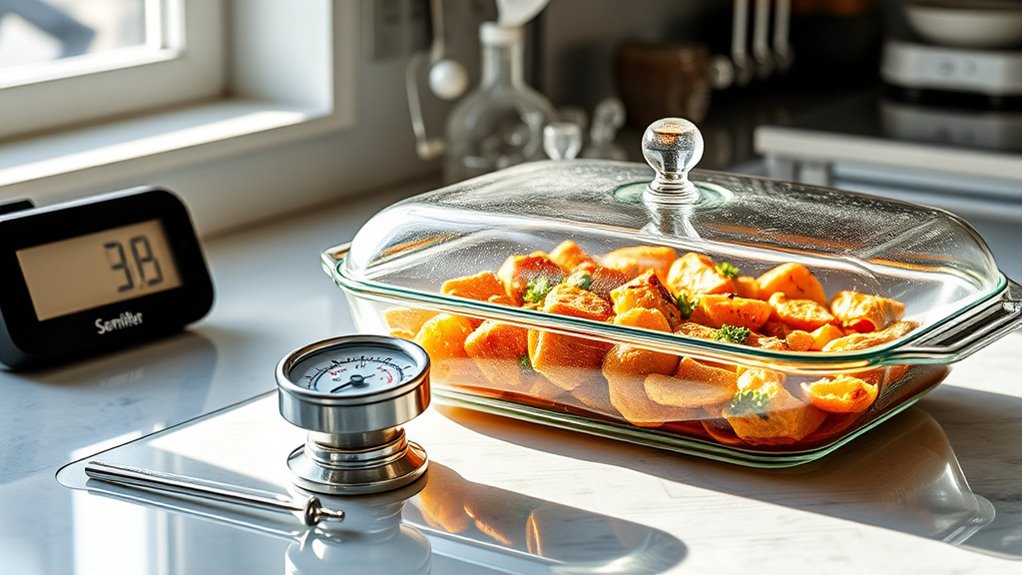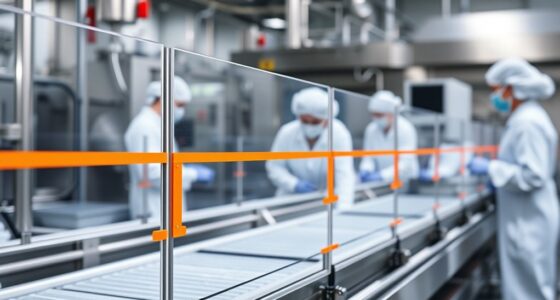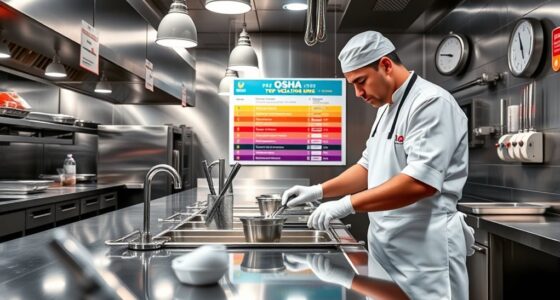To follow the two-step method for cooling and reheating, you should quickly cool hot food within two hours using shallow containers or ice baths to reduce bacteria risks. Reheat leftovers to at least 165°F, stirring and covering for even heat distribution. Store foods at 40°F or below and keep reheated dishes at 140°F if not served immediately. Continuing will help you master how proper techniques keep your food safe and quality high.
Key Takeaways
- Cool hot foods within 2 hours using shallow containers and ice baths to reduce bacteria risk.
- Store leftovers at 40°F or below to prevent bacterial growth during refrigeration.
- Reheat foods quickly to at least 165°F, ensuring even heating with stirring and proper covering.
- Verify internal temperatures with a thermometer before serving or holding.
- Follow the two-step method: first cool safely, then reheat thoroughly for optimal food safety.

Cooling and reheating standards are fundamental for ensuring food safety and maintaining quality. When you handle food, proper temperature regulation is critical to prevent bacteria growth and spoilage. If food isn’t cooled and reheated correctly, you risk foodborne illnesses and compromised taste and texture. That’s why following a disciplined, two-step method is essential to managing these processes safely and effectively.
First, when cooling hot food, you want to minimize the time it spends in the temperature danger zone, which is between 40°F and 140°F (4°C and 60°C). Bacteria thrive in this range, so your goal should be to cool food rapidly from hot temperatures down to 40°F or below within two hours. To do this efficiently, you can divide large quantities into smaller, shallow containers. This increases surface area, allowing heat to dissipate faster. Using ice baths or placing containers in an ice-water mixture helps accelerate cooling. Stirring the food occasionally also promotes uniform cooling. These practices ensure your food moves swiftly through the danger zone, reducing the risk of bacterial growth and guaranteeing food safety.
Minimize time in the danger zone by cooling hot food rapidly within two hours using shallow containers and ice baths.
Once the food has been cooled properly, storing it at the correct temperature is essential. Keep leftovers refrigerated at 40°F or below, and avoid leaving hot food out for extended periods. Proper temperature regulation during storage prevents bacteria from multiplying, preserving both safety and quality. Maintaining proper temperature control is crucial for food safety and quality preservation.
Reheating follows a similar two-step approach. First, you need to heat the food quickly to an internal temperature of at least 165°F (74°C). This temperature effectively kills any bacteria that might have developed. Using a food thermometer is critical here—don’t guess or rely solely on visual cues. Reheat leftovers thoroughly, covering containers to retain moisture and ensure even heating. If you’re reheating large quantities, break them into smaller portions or stir occasionally to distribute heat evenly.
After reheating, it’s equally important to verify the temperature. Once the food hits 165°F, hold it at that temperature for a few minutes to guarantee safety. If you’re not consuming it immediately, keep the reheated food hot at 140°F or above until serving. This continuous temperature regulation minimizes bacteria growth and maintains food safety during service.
Frequently Asked Questions
How Do Standards Vary Across Different Food Types?
You should know that standards vary across food types to guarantee food safety and proper temperature control. For example, cooked meats require cooling from 135°F to 70°F within two hours, then down to 41°F within another four hours. Fruits and vegetables have different cooling times, often needing shorter periods. Always follow specific guidelines for each food type to prevent bacteria growth and ensure safety during cooling and reheating.
What Are the Consequences of Improper Cooling or Reheating?
Poor cooling or reheating can cause serious food safety issues by promoting microbial growth, leading to potential foodborne illnesses. When you neglect proper procedures, bacteria multiply rapidly, risking health hazards and food spoilage. This can result in costly recalls, damage to reputation, and health problems for consumers. Always follow safe cooling and reheating standards to prevent microbial growth and guarantee your food remains safe, fresh, and satisfying for everyone.
Are There Specific Equipment Requirements for Compliance?
You need specific equipment that allows accurate temperature monitoring, like calibrated thermometers or digital probes, to guarantee compliance. Additionally, use equipment that’s easy to clean and maintain, supporting sanitation practices. Properly calibrated devices help you verify that reheating or cooling happens within safe temperature ranges, preventing bacteria growth. Regular sanitation of your equipment is essential to uphold standards and ensure food safety throughout the process.
How Frequently Are These Standards Updated?
Like a river flowing constantly, regulatory updates come regularly to keep industry compliance current. You should check for updates annually or whenever new scientific data or safety concerns emerge. Staying ahead means monitoring official sources and industry notices, ensuring your practices align with the latest standards. This way, you prevent compliance issues and maintain safety, adapting swiftly to changes much like a river adapts to new terrain.
Can These Standards Be Adapted for Large-Scale Industrial Use?
Yes, you can adapt these standards for large-scale industrial use, but you’ll face scaling challenges. To do so effectively, develop compliance strategies that focus on process adjustments and equipment upgrades. You’ll need to customize procedures to handle higher volumes while maintaining safety and quality. By proactively addressing these challenges and implementing scalable solutions, you guarantee adherence to standards and smooth integration into your industrial operations.
Conclusion
By following the two-step method for cooling and reheating, you guarantee food safety and maintain quality. Did you know that improper cooling is responsible for about 40% of foodborne illnesses? Staying vigilant with proper temperature controls not only protects your health but also reduces waste. Implementing these standards is simple and effective. So, take care of your food, and it will take care of you—keeping every meal safe and tasty.









